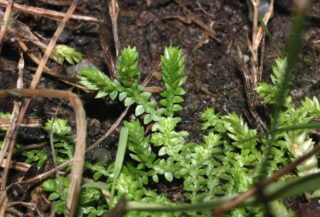
Transforming Selaginella apoda into a major model species
Barbara A. Ambrose and collaborators
Researchers depend on model systems to answer questions related to all aspects of biology. For a species to be effectively used as a model, it needs to have certain biological characteristics, such as the ability to be easily and quickly grown, and community resources are also necessary, including reliable expression protocols, reverse and forward genetic resources, transcriptome sequences, and genome sequences. To fully understand land plant evolution and development, we need to have major model systems developed across the backbone of the land plant phylogenetic tree.

The lycophytes occupy a key phylogenetic position as sister to all vascular plants (ferns, gymnosperms, and angiosperms). Lycophyes dominated the landscape more than 300 million years ago and consisted of large trees and creeping forms. All of the lycophyte tree forms went extinct and are a major component of our coal deposits. The creeping forms of lycophytes have remained nearly unchanged morphologically for approximately 400 million years, which is especially remarkable through periods of massive continental movements and extreme climate change. One amazingly resilient lycophyte, Selaginella lepidophylla, is commonly known as the resurrection plant because it can become completely dry and brown but is able to be resurrected and resume full growth with the addition of water. Lycophytes also have key morphological features, related to reproduction and root development, which are more easily studied than those of other land plants. The study of lycophytes has great potential impacts on agriculture and can provide insights on how plants adapt to climate change. A model system in lycophytes is of critical importance for all plant biologists studying everything from agriculture to diversity and evolution.
We intend to develop forward and reverse genetic resources in the lycophyte Selaginella apoda. We will develop community resources of genetic and genomic information, we will distribute protocols, and we will host workshops to disseminate information about lycophyte and non-angiosperm development and morphology. These resources will turn a lycophyte into a major model system and will be transformative for the study of land plant evolution and development.
Resources and protocols:
Related project: Evolution and Development in Lycophytes and Ferns
Web resource: Animated life cycle: Selaginella apoda
Journal article: Schulz C, Little DP, Stevenson DW, Nowogrodzki A, Paquiot D: Growth and care instructions of a new model species – the lycophyte Selaginella apoda (L.) Spring. Am. Fern J. 2010, 100: 167-171.
Journal article: Schulz C, Little DP, Stevenson DW, Bauer D, Moloney C, Stützel T: An overview of the morphology, anatomy, and life cycle of a new model species – the lycophyte Selaginella apoda (L.) Spring. Int J Plant Sci. 2010, 171: 693-712.
Workshops: Coming soon
1. The growth, life cycle, and morphology of Selaginella apoda.
2. The evolution and morphology of vascular plants.
Germplasm
For cuttings and/or spores of Selaginella apoda, please contact bambrose@nybg.org.